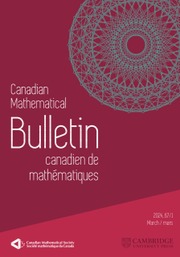Article contents
Non-spectral Problem for Some Self-similar Measures
Published online by Cambridge University Press: 28 August 2019
Abstract
Suppose that  $0<|\unicode[STIX]{x1D70C}|<1$ and
$0<|\unicode[STIX]{x1D70C}|<1$ and  $m\geqslant 2$ is an integer. Let
$m\geqslant 2$ is an integer. Let  $\unicode[STIX]{x1D707}_{\unicode[STIX]{x1D70C},m}$ be the self-similar measure defined by
$\unicode[STIX]{x1D707}_{\unicode[STIX]{x1D70C},m}$ be the self-similar measure defined by  $\unicode[STIX]{x1D707}_{\unicode[STIX]{x1D70C},m}(\cdot )=\frac{1}{m}\sum _{j=0}^{m-1}\unicode[STIX]{x1D707}_{\unicode[STIX]{x1D70C},m}(\unicode[STIX]{x1D70C}^{-1}(\cdot )-j)$. Assume that
$\unicode[STIX]{x1D707}_{\unicode[STIX]{x1D70C},m}(\cdot )=\frac{1}{m}\sum _{j=0}^{m-1}\unicode[STIX]{x1D707}_{\unicode[STIX]{x1D70C},m}(\unicode[STIX]{x1D70C}^{-1}(\cdot )-j)$. Assume that  $\unicode[STIX]{x1D70C}=\pm (q/p)^{1/r}$ for some
$\unicode[STIX]{x1D70C}=\pm (q/p)^{1/r}$ for some  $p,q,r\in \mathbb{N}^{+}$ with
$p,q,r\in \mathbb{N}^{+}$ with  $(p,q)=1$ and
$(p,q)=1$ and  $(p,m)=1$. We prove that if
$(p,m)=1$. We prove that if  $(q,m)=1$, then there are at most
$(q,m)=1$, then there are at most  $m$ mutually orthogonal exponential functions in
$m$ mutually orthogonal exponential functions in  $L^{2}(\unicode[STIX]{x1D707}_{\unicode[STIX]{x1D70C},m})$ and
$L^{2}(\unicode[STIX]{x1D707}_{\unicode[STIX]{x1D70C},m})$ and  $m$ is the best possible. If
$m$ is the best possible. If  $(q,m)>1$, then there are any number of orthogonal exponential functions in
$(q,m)>1$, then there are any number of orthogonal exponential functions in  $L^{2}(\unicode[STIX]{x1D707}_{\unicode[STIX]{x1D70C},m})$.
$L^{2}(\unicode[STIX]{x1D707}_{\unicode[STIX]{x1D70C},m})$.
MSC classification
- Type
- Article
- Information
- Copyright
- © Canadian Mathematical Society 2019
Footnotes
The research is supported in part by the NNSF of China (No. 11831007, No.11571099).
References
- 3
- Cited by


